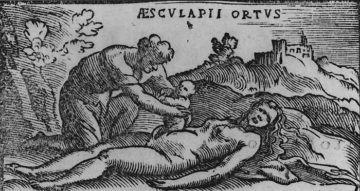by Godfrey Onime

Short and snappy, the smooth-faced lieutenant-colonel who had been appointed deputy inspector-general of hospitals for the British army would butt heads with non-other than the chaste, indefatigable Florence Nightingale. A heroine of Victorian England who was celebrated as the pioneer of nursing during the Crimean War, Nightingale wrote to her sister about their clash, “He behaved like a brute… the most hardened creature I have ever met.”
His name was Dr. James Miranda Barry. Obsessed with hygiene, when inspecting his troops he would bark, “Dirty beasts! Go and clean yourselves!” The standards of even ‘the lady of the lamp’ Nightingale were not high enough for Dr. Barry, and I can just imagine the differential Nightingale trying not to show her fuming as the doctor berated her in front of her subordinates. Unlikely as it may seem, this short-tempered “brute” turned out to be the champion of women, or more specifically, of pregnant woman – a reason that became more understandable only after his death.
###
The stretching and kicking. The quickening of baby and mother’s hearts. Pregnancy is often a happy time, when families await the precious addition. Before that addition could happen though, there must be a birth – and commonly, such deliveries can be fraught with dire complications. Queen Victoria, who bore nine children, put it succinctly when she wrote, “Being pregnant is an occupational hazard of being a wife.”
In the United states and Europe, such life-and-death complications that can plague labors now commonly end in surgery. But not the case in some cultures, such as the West African country, Nigeria – leading in part to too many women needlessly dying. A yet other side of the dilemma is that although the surgery is now believed to be over performed in the United States, some women who truly need it sometimes refuse one. Welcome to the treacherous world of caesarean section — or c-section.
I shudder when I think of the staggering statistics: In Nigeria, for instance, nearly 60,000 women die every year in childbirth, earning the country the notoriety of one of the highest maternal mortality rates in the world. This horrendous waste of lives is partly because of the country’s low caesarean surgery rate: a measly 2 in every 100 births, compared to the global rate of 21%, or about 1 in 5 deliveries. At the other extreme, the c-sections rate in the United States has exploded to 32%, or 1 in 3 births, which is generally thought to be excessive. Ironically, this concern of overuse – sometimes echoed in the news media or by patient-advocates – is partly why some women who may benefit from c-section refuse one in countries like the United States. Of course there are other complex reasons for these refusals in both countries where caesareans are under-performed as well as where overused, including cultural, religious, and yes, inequity. But first, let’s ponder the extra-ordinarily history of c-section – and the story of Dr. James Barry, the intriguing British surgeon who went to extra-ordinary lengths to offer the often life-saving procedure to women.
###
References to c-section dates back thousands of years, and appear in the ancient Hindu, Egyptian, Grecian, Roman, and other folklore. For instance, the legend of the Greeks sun god Apollo is quite telling—that he ripped his son Asclepius from the mother’s belly while she was dying. Ancient Chinese arts further demonstrate babies being removed from cuts on women’s wombs and abdomens.

Earliest records of c-sections indicate that the procedure was reserved for the dead or women who were not expected to survive labor. This is not hard to fathom. Early surgery was highly fatal, what with the use of crude, unsterilized surgical instruments and the lack of anesthesia and antibiotics. So, it was highly unlikely that mothers would survive c-sections then. As for the term caesarean section, some believed that it derived from Julius Caesar, who was allegedly extracted from his mother through a cut in the abdomen. However, many historians now contest this, given that Caesar’s mother lived into his adulthood; she would very likely not have survived a c-section surgery during that period.
Due to the hazards that can plague childbirth, it is not surprising that many doctors continued to practice c-section to at least save the baby of a dying mother. In time, though, women began to survive as well. That is where the oddball Dr. Barry comes in, who not only championed humane treatments of those in the fringes of society, including slaves and lepers, but of women. The military had sent him around the world, including to Canada, India, Jamaica, South Africa, among others, and he enjoyed traveling. While in South Africa, Dr. Barry is credited with performing the first known successful c-sections in which both mother and baby survived, in 1826. His particular sympathy for women became better appreciated after the doctor died. Those preparing his body for the undertakers would discover that Dr. Barry was “a most complete and perfect woman.” It turns out that Dr. Barry was actually a “she,” and not a “he.” What the she-turned-he had orchestrated was to masquerade as a man in order to study medicine at the university, which was denied women at that time; Dr. Barry kept up the deceit afterwards in order to practice medicine. While generally loving and caring towards patients, it has been argued that Dr. Barry may have in part put up the tough “brut” act to perpetuate the “male” identity.

It was not until after anesthesia was discovered in the mid-1800s that c-section became less dreaded. This was fortuitous because the turn of the 20th century saw an explosion in the epidemic of rickets amongst malnourished families in crowded cities. A skeletal disorder, rickets led to malformed bones, including of the pelvis. This can impede normal childbirth and become fatal for a mother, baby, or both. C-sections came to the rescue for many of these women. Rickets would eventually become linked to vitamin D deficiency, thanks to the works of Drs. Alfred F. Hess and Harry Steenbock, who by 1924 independently discovered that UV irradiation of various foods can fortify them with vitamin D — foods such as milk, oils, and cereals. In the US, milk was chosen and enriched with vitamin D and Rickets soon essentially vanished. But not c-sections, which continued to flourish.
###
Today, the World Health Organization (WHO) projects a c-section rate of 5% as ideal to ameliorate maternal and fetal demise—a value that more than doubles the just 2% rate in Nigeria. Women — and babies — die when medical c-sections are not used in the right setting, such as preventing obstructed labor. Such blockage can be because a baby is too big to transverse the birth canal, or is in a breech position, or that the mother’s pelvis is too small. Without intervention, the baby may become asphyxiated; the uterus can also become lacerated or ruptured and cause fatal hemorrhages.
At the other extreme of c-sections, the 32% rate in the United States dwarfs the 5% WHO’s recommendation (some places, such as areas in the Dominican Republic and Brazil, have even more astounding rates–about half of all deliveries). It is worth noting that c-section is a major abdominal surgery; excessive, needless surgery can have it’s own set of complications. These may include dangerous hemorrhages from placental detachments, infections, blood clots, or delayed healing.
When life-saving medial c-section is needed, researchers have identified several reasons why many women refuse one in countries like Nigeria and even the United States. Refusals can be due to a combination of cultural and religious beliefs. For instance, Christian women commonly hear of the verses in the Bible exhorting the “vigorous” and stoic “Hebrew woman” who delivers vaginally, unattended by midwives. This mythic prowess to deliver vaginally is often a symbol of maternal virtue in countries like Nigeria. As Adepeju Jaiyeoba told BBC, “Nigeria is a deeply religious country, and everything is very spiritualised.” Jaiyeoba is the founder of Nigeria’s Brown Button Foundation which is working to improve maternal mortality.
I spoke with Joshua Olabisi, who was a long-time nurse, practicing both in Nigeria and the United States, and who also happens to be my father-in-law. He agrees that c-section can be stigmatized in the Nigerian culture. Here’s how he explained it,
“It’s a point of prayer even, ‘You will never deliver your child by c-section.’ For those who do not deliver naturally, they are looked at as inadequate mothers, a half-mother. It is said that they can carry the pregnancy, but cannot deliver, so it’s like a stigma. Sometimes they are afraid to scold their own child because just to get under their skin the elderly would say, ‘You will do that, you will maltreat the child, because you do not know the pain of childbirth. You delivered by the knife.’ So the surgery always hangs around their neck, so many women would not want to have c-section.”
To complicate matters, in some cultures women often have limited control over their own pregnancies. For instance, hospitals routinely encounter women who refuse c-section for fear of bringing shame to their families. In one case study, 90% of Nigerian women believed that the role of signing the consent form permitting c-section rested on the man. While the situation is arguably less radical in countries such as the United States or UK, women who have c-sections can also have stigma associated with it.
Some yet other important factors leading to the low c-section rates in countries like Nigeria are worth exploring: costs and poor access, or inequity. Many women give births in rural areas with no trained obstetricians or midwifes. In the urban centers, the cost for deliveries in hospitals can be prohibitive, and c-sections can be especially so. Besides the stigma associated with caesareans earlier observed, “It also caries a lot of financial burden,” my father-in-law Olabisi explained. Then, there is not only a shortage of well trained obstetricians even in the cities, but many facilities can be substandard and have too many stories of butcher-jobs after c-sections told and the mortality rates astronomical — further dissuading many who truly need the procedure from accepting one.
Perhaps more dumbfounding is the situation in a place like the United States, where the procedure and trained professionals are readily available — too available, some might say. Here too inequity can play significant roles in how women experience the issues of c-sections. The ethical concerns associated with refusals of caesareans have become quite vexing as well. They have for instance raised such questions as: When the doctors think a woman’s life and/or that of the unborn baby is at risk, who has priority — the woman or the baby? In many cases, to save the woman and/or the baby’s lives, many hospitals have rushed to get court orders to forcibly operate on a competent woman refusing c-section. Medical ethicists are continuing to debate just how to handles such cases.
In the United States, the question of inequity is further compounded by the concern of coercion among some populations. Some fear that many women who may not need caesareans are often compelled to have one — and majority of these mothers are marginalized minorities. One survey of court-ordered obstetrical interventions, published in the New England Journal of Medicine, found that 81 percent of the women were minority, and 24 percent did not speak English as a primary language. Another analysis of overuse of caesareans found that black women in the United States received the surgery even for low-risk pregnancies at a rate of 4.5% more often than whites. How can these be? Why does the United States overuse caesareans at all?
Several reasons account for this — why some doctors and American hospitals may push for c-sections, even amongst low-risk individuals. For one, money. Cesareans pay about $5,000 more than vaginal deliveries, most of which is covered by insurance. There is also the contributions of time management for doctors and hospitals—although c-sections take about 45 minutes, women can labor for hours, even days. Then consider that caesareans can help lawsuits-weary obstetricians avoid bad outcomes for the baby, and the perfect storm is set. Unfortunately, these factors leading to some overuse in the United States only add to the desire by some women who may seriously need caesareans to refuse surgery. But one thing remains clear: Where indicated, c-sections save lives.
Indeed, cesareans have come a long way since Dr. Barry performed the first truly successful case that saved mother and baby. When I contemplate the maddening complexities today dogging the surgery that Dr. Barry pioneered, I can only wonder: What compelled the doctor to so much want to practice medicine as to masquerade as a man for 56 years? After all, she could have practiced nursing in the manner of the likes of Florence Nightingale. But the doctor ostensibly saw something else in her crystal ball.
What Dr. Barry envisioned was a bigger ambitions than the restrictive roles accorded women of her generation. Born Margaret Ann Bulkley around 1789, it is believed that she was rapped at about age 13, perhaps by her wayward uncle Redmond Barry, who drifted in and out of jobs and town. It is believed that the young Margaret had the child, who was raised by her mother. Undoubtedly, Margaret was way ahead of her time, the woman’s role then too suffocating for her. In a letter to her brother long before hatching the plan to attend medical school as a “man,” she once wrote, “Had I been a man, I would have become a soldier.” Well then, a heck of a soldier she did become. Whatever the motivations of the Margaret-turned-Dr-Barry, it is only fitting that the story of the life-and-death procedure that this improbable doctor helped to advance remains as perplexing as the surgeon herself. Correction: himself. No, her and himself.
